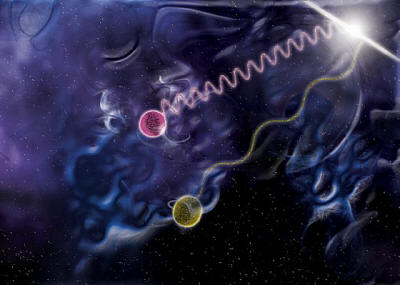|

by Janet Wilson
August 13, 2012
from
UCI Website
UCI researchers say data from
NASA telescope
is of ‘high statistical
significance’
Irvine, Calif.
Gamma-ray photons seen emanating
from the center of the Milky Way galaxy are consistent with the
intriguing possibility that dark-matter particles are annihilating
each other in space, according to research submitted by UC Irvine
astrophysicists to the American Physical Society journal Physical
Review D.
Kevork Abazajian, assistant
professor, and
Manoj Kaplinghat, associate
professor, of the Department of Physics & Astronomy analyzed data
collected between August 2008 and June 2012 from NASA’s
Fermi Gamma-ray Space Telescope
orbiting Earth.
They found more gamma-ray photons coming
from the Milky Way galactic center than they had expected, based on
previous scientific models. Gamma-rays are electromagnetic radiation
emitted during radioactive decay or other high-energy particle
processes.
“This is the first time this new
source has been observed with such high statistical
significance, and the most striking part is how the shape,
spectrum and rate of the observed gamma rays are very consistent
with the leading theories for dark matter,” Abazajian said.
“Future observations of regions with
less astrophysical emission, such as dwarf galaxies, will be
able to conclusively determine if this is actually from the dark
matter.”

In this
illustration, one photon (purple) carries a
million times the energy of another (yellow).
Some
theorists predict travel delays for
higher-energy photons, which interact more
strongly with the proposed frothy nature of
space-time.
Yet Fermi
data on two photons from a gamma-ray burst fail
to show this effect, eliminating some approaches
to a new theory of gravity.
The
animation link below shows the delay scientists
had expected to observe.
Credit:
NASA/Sonoma State University/Aurore Simonnet
Non-luminous and not directly
detectable, dark matter is thought to account for 85 percent of the
universe’s mass. Its existence can only be inferred from its
gravitational effects on other, visible matter.
The UCI researchers’ findings could
support its presumed presence at the center of galaxies.
The prevailing hypothesis is that dark matter is composed of
weakly interacting massive particles, or
WIMPs. When two WIMPs meet, they
annihilate each other to produce more familiar particles - including
gamma rays.
Although the data interpretation seems to be consistent with
dark-matter theory, the gamma rays could be coming from a source
other than WIMP destruction, Kaplinghat noted.
“The signal we see is also
consistent with photons emitted by pulsars,” he said, “or from
high-energy particles interacting with gas in the galactic
center.”
|

